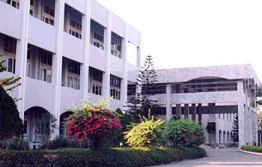In the Strange Church of the Dictatorship
By Stephen Brookes in Rangoon
for Asia Times
Suggest a trip to the Defense Services Museum, and most visitors to Yangon balk. They gather their children behind them and back away warily, muttering about pagodas and tight schedules. But for anyone really interested in understanding Myanmar, the museum is an essential stop. It's a direct and fascinating look into the conflicted heart of the State Law and Order Restoration Council (SLORC) -- the military junta that runs the country.
 Since the SLORC assumed power after the uprisings of 1988, it's been trying to present a kinder, friendlier face to the world -- and pounding that message in as often as possible. There are billboards all over the country singing the praises of the Tatmadaw (as the military is known), insisting that it will never betray the country. And the defense museum, which is the junta's forum for explaining itself to the people, is full of the strange tension between rigid control and apparent goodwill that underlies almost everything that the SLORC does.
Since the SLORC assumed power after the uprisings of 1988, it's been trying to present a kinder, friendlier face to the world -- and pounding that message in as often as possible. There are billboards all over the country singing the praises of the Tatmadaw (as the military is known), insisting that it will never betray the country. And the defense museum, which is the junta's forum for explaining itself to the people, is full of the strange tension between rigid control and apparent goodwill that underlies almost everything that the SLORC does.
That tension is clear from the moment you walk in the gates: two unsmiling, machinegun-toting guards examine you, peer into your bag for cameras, then allow you to approach a small ticket booth. Over the ticket taker's window, there's a small sign announcing the $3.00 entry fee -- and it's drawn in red pencil with a big, red heart.
Despite that oddly charming note, it's clear at first glance that the museum is meant to be epic in scale and authoritative in tone -- a monument to the power of the Tatmadaw. The building is an exercise in epic International Style, with Mussolini-esque sweeps of open space and armed guards stationed picturesquely by the doors.
But once through the marble-columned portico and past a stern photographic gauntlet of the country's military leaders, you immediately notice that you're alone. Aside from the occasional bewildered tourist and the ubiquitous cleaning ladies -- who look up, startled, as you pass -- the museum is almost always empty.
There are, of course, weapons -- thousands of them. And there's an infectious enthusiasm about the weaponry on display, from Japanese artillery seized in WWII, to vast arrays of machine guns and depth charges, to a selection of armored cars, to the deck and cabin of a Myanmar patrol boat, removed whole and mounted on the floor. Another huge, hanger-like room holds fifteen warplanes and helicopters, complete with exhibits on parachutes and ejection seats.
And the wonderful thing about the displays is that they aren't done in the sober, reflective way that you find at, for example, the Air and Space Museum in Washington, DC. Here, the guns are flanked by lurid dioramas that look as if they were designed by 12-year-old boys. One shows a gory plane crash, replete with broken bodies, screaming victims and melted plastic planes. Another has a mismatched set of tanks rolling through a landscape of demolished houses -- with a perfect pagoda gleaming on a perfect hill in the background. And a huge aquarium, filled with greenish water and small plastic boats, depicts an outsized frogman attaching a mine to the underwater struts of a bridge. On the front of the aquarium is a sticker that reads, "I Love Tetra."
But the weaponry exhibits run out quickly, and the broader, more complex range of the military begins to reveal itself. Mount the stairs to the second floor and what looks like a souvenir shop turns out to be a display of shoes from the Tatmadaw Footwear Factory. There are combat and jungle boots, of course -- but also rows and rows of furry slippers and three different styles of golf shoe. And a whole separate case holds what are labeled "experimental products," including gold high heels and a green suede "shooting vest."
As you move from room to room and from floor to floor, the width of the SLORC's grasp over almost everything in the country becomes clear. One large room is given over to agriculture, complete with dioramas of cows in fields, a stack of baskets for holding pigs and a case full of cans of Tatmadaw "Bamboo Shoot and True Pea." Another room houses detailed displays of the military's medical advances, and yet another contains records of the SLORC's accomplishments in foreign policy.
Nor is the economy neglected. The next floor up houses an exhibit of credit cards (something not seen until a year ago) and bank passbooks for foreign currency holders -- another novelty. There are displays of the country's exports (including jars of fish in formaldehyde) and an exhibit showing "export garments of joint ventures" that highlights shirts bearing the Eddie Bauer logo -- even though that company pulled out of Myanmar last year because of criticism over the SLORC's human rights policies.
In fact, the government seems to be curiously nonchalant about such outside criticism. Charges that it conscripts labor and mistreats political prisoners don't seem to worry it. The top floor of the museum is proudly home to an informative exhibit on the prison system itself, explaining the SLORC's philosophy ("to utilize fully unused prisoners' services in national development projects") and detailing the Prison Department's operations. And the whole display is right next to another one explaining the workings of the Manpower Department, with a huge national map showing "prisons, breeding work sites, agricultural sites and quarry sites."
But it's not until you climb the last flight of stairs and make it to the top floor that the meaning of the whole museum finally becomes clear. For here (after you've found an attendant and gotten him to turn the lights on for you) is the government's vision of its own future.
And it has nothing to do with firepower. Laid out in loving detail under a wide glass case is a vast, detailed model of the Future of Yangon. There are the old colonial buildings, the wide streets, the green parks, carefully painted and built to scale. But they only seem to be a backdrop for the modern new buildings going up -- the Traders Hotel, the FMI Building, the International Business Center and dozens of others. And as they go up, the neglected city of Yangon is being transformed.
And that could be what the SLORC sees as its next great goal. For it is now arguing that, with the country stable and at peace, its new job is to develop the economy and bring Myanmar up to par with the rest of South East Asia. Forget the guns and the bloody dioramas of the first floor -- the military's new battlefield is the economy.
References (4)
-
 Response: http://www.couponactive.online/woot
Response: http://www.couponactive.online/woot -
 Response: Sewing Machine Hidden Feature
Response: Sewing Machine Hidden Feature -
 Response: Candles
Response: Candles -
 Response: Snowshoeing
Response: Snowshoeing


Reader Comments